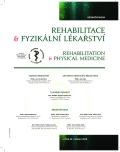Electrostimulation as an Effective Tool in Therapy of Vocal Cords
Authors:
D. Valíček 1; V. Buldová 2
Authors‘ workplace:
REFIT s. r. o., Partizánske
1; MNO, Ostrava
2
Published in:
Rehabil. fyz. Lék., 24, 2017, No. 1, pp. 37-42.
Category:
Case Report
Overview
Background:
Electrostimulation has been an important factor in the treatment of paresis. We therefore decided its application in the therapy of patients with iatrogenic and idiopathic paresis of vocal cords, although this indication had been so far only occasional. Vocal cord paresis (recurrent nerve paresis) results in phonation problems, but also to respiratory problems and it is therefore necessary to begin the treatment early.
Cohort and methods:
The case study concerned two patients. The first one, a retired male patient, 64 years of age, a business representative, was subjected to endarterectomy, laryngostroboscopy with resulting dysphonia of 2nd to 3rd degree, and paresis of pl. voc. sin. of the iatrogenic type which resulted from surgery. The second patient, a women aged 29 years, a cleaning lady, was subjected to total thyroidectomy and fiberoptic laryngoscopy with resulting paresis of the left vocal cord in paramedial position with dysphonia of 2nd to 3rd degree. Both patients suffer from considerable phonation limitations. At the beginning of therapy both patients were subjected to detailed examinations at the ORL outpatient department. They were subsequently sent to a rehabilitation physician outpatient department. After his indications and exclusion of possible contraindications they were sent to a rehabilitation ward for treatment. Electrostimulation of pharyngeal muscles with cathode applied on thyroid cartilage and anode applied to the patient’s contralateral back of the neck. The applied impulse was 300-500ms and 2-3 ms pause, supra-threshold selected individually according to tolerance of the patient. The treatment was applied 10 times and three to five times weekly. The patient were also subjected to voice and breathing exercise under the guidance of a physical therapist. The therapy was followed by the control examination of a rehabilitation physician with a possibility to continue the treatment including possible individual corrections according to needs of the patient. The authors compared the entry and final examination by laryngoscopy, phonation and respiration abilities, subjective feeling of the patient during the therapy and afterwards and the physician’s opinion.
Results:
The patients viewed Electrostimulation favorably, the physician evaluated voice as improved with better resonance. Laryngoscopy demonstrated improvement of vocal cords mobility with better resonance. Dysphonia was improved by one degree in the first patient and by 0.5 degree in the second patient.
Conclusion:
The completed treatment was evaluated favorably with expected favorable result not only from the patient’s point of view, but also as viewed by the physician and physical therapist. Laryngoscopy also confirmed changes to the better. Electrostimulation is substantiated and occupies an important position in the treatment of vocal cord paresis as well. It also fulfills an important psychological constituent in general therapy of the patient. The authors recommend to explore the problems is a larger group of patients.
Keywords:
electrostimulation, vocal cords, paresis
Sources
1. DVOŘÁK, J.: Štítná žláza a její nemoci. Praha, Nakladatelství Serifa, 2002, 138 s. ISBN: 80-902859-1-0.
2. GANGALE, DEBRA C.: Rehabilitace orofaciální oblasti. Bratislava, Grada Publishing , 2004, 232 s. ISBN 8024705346.
3. GILMAN, M., GILMAN, L.: Elektrotherapy and the human voice: A literature review of the historici origins and contemporary aplications. Journal of Voice., roč. 22, 2008, č. 2, s. 213-219, ISSN 0892-1997.
4. HUDÍKOVÁ, M., DRŠATA, J.: Paréza zvratného nervu. Neurologie pro prax., roč. 13, 2012, č. 5, s. 259-260, ISSN 1213-1814.
5. IAKOVLEVA, I., ILIUTOVICH, G., IUVALOVA, N.: On the use of sinusoidal low –frequency modulated currents in vocal disorders in patient with paralysis and paresis if the laryngeal muscle. Vestn. Otorinolaringol., roč. 27, 1965, č. 5, s. 93-98, ISSN 0042-4668.
6. KATADA, A. a kol.: Functional electrical stmulation of laryngeal adductor muscle restores mobility of vocal fold and improves voice sounds in cats with unilateral laryngeal paralysis. Neuroscience Research [ online]., roč. 2, č. 50, [ cit. 2016-09-19]. Dostupné z www: http://ncbi.nlm.nih.gov/pubmed/15380322. ISSN 0168-0102.
7. KUČERA, M., FRIČ, M., HALÍŘ, M.: Praktický kurz hlasové rehabilitace a reedukace. Opočno, 2010, 58 s., ISBN -978-80-25-6592-9.
8. LAGORIO, A., CARNABY, M. a kol.: Treatment of vocal fold bowing using neuromuscular electrical stimulation. Archives of Otolaryngology–Head & Neck Surgery, roč. 4, 2010, č. 136, s. 398-403, ISSN 0886-4470.
9. LAŠŤOVKA, M.: Léčba pares n. recurrentis pomocí přímé stimulace vnitřních hrtanových svalů. Otolaryngoogie a foniatrie, roč. 48, 1999, č. 4, s. 226-228, ISSN 1210-7867.
10. PODĚBRADSKÝ, J., PODĚBRADSKÁ, R.: Fyzikální terapie. Praha, Vydavateľstvo Grada, 2009, 218 s. ISBN 978-80-247-2899-5
11. PTOK, M., STRACK, D.: Voice exercice therapy versus elektrostimulation therapy in patients with uniateral vocal fld paralysis. HNO [online]., roč. 53, 2005, č. 12.[ cit. 2016-09-19]. Dostupné z www: http://ncbi.nlm.nih.gov/pubmed/15711943, ISSN 0017-6192.
12. TRABOULSI, J. a kol.: Elektrostimulace nepohyblivé hlasivky-metodika v naší modifikaci. Otorhinolaryngology & Phoniatrics/Otorinolaryngologie a Foniatrie., roč. 62, 2013, č. 4, s. 198-200, ISSN 12107867.
Labels
Physiotherapist, university degree Rehabilitation Sports medicineArticle was published in
Rehabilitation & Physical Medicine

2017 Issue 1
- Hope Awakens with Early Diagnosis of Parkinson's Disease Based on Skin Odor
- Deep stimulation of the globus pallidus improved clinical symptoms in a patient with refractory parkinsonism and genetic mutation
Most read in this issue
- Robotic Rehabilitation of the Hand Spasticity
- Electrostimulation as an Effective Tool in Therapy of Vocal Cords
- Prop Up Movement Patterns and their Effect on Patients after Total Hip Replacement
- A Photomechanic Effect of High-Intensity Laser of Class 4 1064nm on the Pain Transfer Via Free Nerve Endings: a Multi-Centric, Randomized, Placebo-Controlled Study
